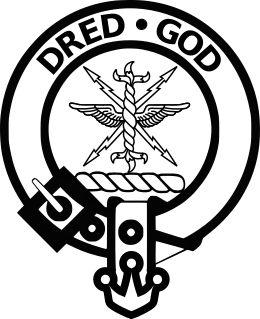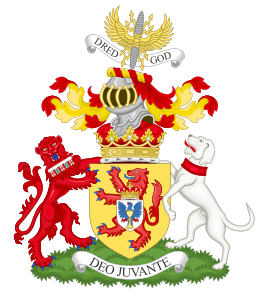Clan Carnegie facts for kids
Quick facts for kids Clan Carnegie |
|||
|---|---|---|---|
 |
|||
| Motto | Dred God | ||
| Profile | |||
| District | Angus | ||
| Chief | |||
 |
|||
| David Carnegie | |||
| His Grace the 4th Duke of Fife | |||
| Seat | Elsick House | ||
|
|||
|
|||
Clan Carnegie is a Lowland Scottish clan. This means it's a group of families from the low-lying areas of Scotland who share a common history and often a family name. The Clan Carnegie has a long and interesting past, with brave warriors and important leaders.
Contents
The Story of Clan Carnegie
How the Clan Began
The story of Clan Carnegie starts a long time ago, in 1358. A man named Walter de Maule gave some land called Carnegie in Angus to John de Balinhard. We don't know much about where the Balinhards came from, but their lands were close to Arbroath. Some people thought they might be related to the Ramsays, but there's no clear proof.
Battles and Important People (1400s-1500s)
Around 1401, Duthac de Carnegie got some land in Kinnaird, also in Angus. He officially owned these lands from Robert Stewart, Duke of Albany in 1409. Sadly, Duthac de Carnegie was killed in a big battle called the Battle of Harlaw in 1411.
He left behind a young son, Walter Carnegie of Kinnaird. Walter grew up to be a fighter and supported James II of Scotland. He fought at the Battle of Brechin in May 1452 alongside the Earl of Huntly. They won against rebels led by the Earl of Crawford (who was the chief of Clan Lindsay). In revenge, the Earl of Crawford burned the village of Kinnaird.
Later, John Carnegie of Kinnaird fought and died at the Battle of Flodden in 1513. His son, Sir Robert Carnegie, made Kinnaird even bigger. He became a judge in a special court called the College of Justice in 1547. He was also sent to England to help get the Earl of Huntly back after he was captured in another battle. Sir Robert Carnegie was the first in his family to say that his ancestors were "cup bearers" to the Scottish king. This is why the family's coat of arms has an old-fashioned cup on it!
Sir Robert's son, John Carnegie, was very loyal to Mary, Queen of Scots. He never stopped supporting her, even when many others did. He passed away in 1595, and his younger brother, Sir David Carnegie, took over the family estates.
Nobility and Challenges (1600s)
David Carnegie became a Lord in 1616, known as Lord Carnegie of Kinnaird. Later, in 1633, he was given an even higher title: Earl of Southesk. His brother, Sir John Carnegie, also became a Lord in 1639 and then the Earl of Ethie in 1647.
James Carnegie, the 2nd Earl of Southesk, visited the exiled King Charles II of England in Holland in 1650. He also served as a representative for Scotland in the English Parliament during a time called The Protectorate. He was almost killed in a fight with another nobleman in London in 1660. Sadly, a younger son of the third Earl was killed in a fight in Paris in 1681.
Supporting the Jacobites (1700s)
The Clan Carnegie supported the Jacobites. These were people who believed that the old royal family, the Stuarts, should still be kings of Scotland and England. The fourth Earl didn't fight against the Glorious Revolution of 1688, but he stayed away from the royal court afterwards.
His son, the fifth Earl, joined the "Old Pretender" (who was James Francis Edward Stuart, the son of the exiled King James VII/II) during the Jacobite rising of 1715. Because of this, the government took away his titles and lands. The fifth Earl died in 1730, and all his children had died young. The family leadership then passed to John Carnegie of Pittarrow, who was from a younger branch of the family. This branch had been given the title of "Baronets of Nova Scotia" in 1663.
Modern Times
The sixth Baronet was a brave soldier. In 1855, he managed to get a special law passed that gave back the titles of Earl of Southesk and Lord Carnegie of Kinnaird and Leuchars to the family. The ninth Earl chose the title "Baron of Balinhaird" to remember his family's very old beginnings.
The eleventh Earl married Princess Maud, who was the younger daughter of the Princess Royal and granddaughter of King Edward VII. Her son inherited his father's title of Earl of Southesk and became the chief of Clan Carnegie. He also inherited the title of Duke of Fife from his mother's side of the family. When the eleventh Earl died in 1992, his son, the Duke of Fife, became the clan chief. The Earldom of Southesk is still an important title in honor of his Carnegie ancestors.
Clan Tartan
The Carnegie tartan, which is a special pattern of plaid, is based on the Glengarry tartan. It was adopted during these times.
Clan Chief
As of 2015, the chief of Clan Carnegie is His Grace David Carnegie. He holds many titles, including 4th Duke of Fife, Earl of Southesk, and Chief of the Name and Arms of Carnegie.
Clan Seat
The main home of the Clan Carnegie is Elsick House.
See also

